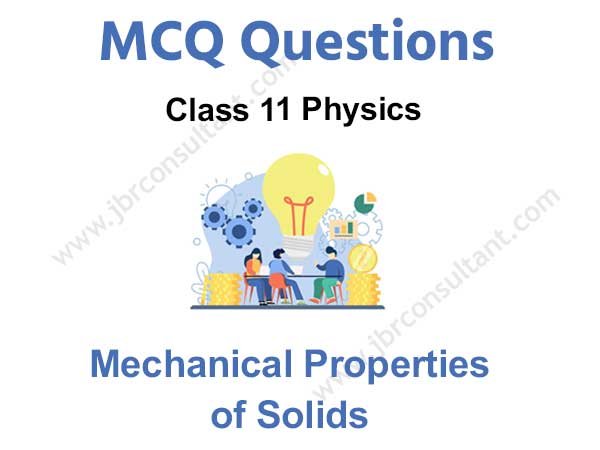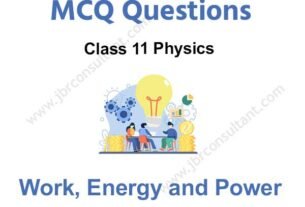Mechanical Properties of Solids Class 11 MCQ is one of the best strategies to prepare for the CBSE Class 11 Board exam. If you want to complete a grasp concept or work on one’s score, there is no method except constant practice. Students can improve their speed and accuracy by doing more MCQ on Mechanical Properties of Solids Class 11, which will help them all through their board test.
Mechanical Properties of Solids Class 11 MCQ Questions with Answer
Class 11 Physics MCQ with answers are given here to Chapter 9 Mechanical Properties of Solids. These MCQs are based on the latest CBSE board syllabus and relate to the latest Class 11 Physics syllabus. By Solving these Class 11 MCQs, you will be able to analyze all of the concepts quickly in the chapter and get ready for the Class 11 Annual exam.
Learn Class 11 Mechanical Properties of Solids MCQs with answers pdf free download according to the latest CBSE and NCERT syllabus. Students should prepare for the examination by solving CBSE Class 11 Physics Mechanical Properties of Solids MCQ with answers given below
Question 1. The approximate depth of an ocean is 2700 m.
The compressibility of water is 45.4 × 10–11 Pa–1 and density of water is 103 kg/m3. What fractional compression of water will be obtained at the bottom of the ocean?
(a) 1.2 × 10–2
(b) 1.4 × 10–2
(c) 0.8 × 10–2
(d) 1.0 × 10–2
Answer
A
Question 2. Copper of fixed volume V is drawn into wire of length l. When this wire is subjected to a constant force F, the extension produced in the wire is Dl. Which of the following graphs is a straight line?
(a) Dl versus 1/l
(b) Dl versus l 2
(c) Dl versus 1/l 2
(d) Dl versus l
Answer
B
Question 3. The bulk modulus of a spherical object is ‘B’. If it is subjected to uniform pressure ‘p’, the fractional decrease in radius is
(a) B/3p
(b) 3p/B
(c) p/3B
(d) p/B
Answer
C
Question 4. The Young’s modulus of steel is twice that of brass.
Two wires of same length and of same area of cross section, one of steel and another of brass are suspended from the same roof. If we want the lower ends of the wires to be at the same level, then the weights added to the steel and brass wires must be in the ratio of
(a) 4 : 1
(b) 1 : 1
(c) 1 : 2
(d) 2 : 1
Answer
D
Question 5. Which of the following affects the elasticity of a substance?
(a) hammering and annealing
(b) change in temperature
(c) impurity in substance
(d) All of these
Answer
D
Question 6. The following four wires are made of the same material. Which of these will have the largest extension when the same tension is applied?
(a) length = 200 cm, diameter = 2 mm
(b) length = 300 cm, diameter = 3 mm
(c) length = 50 cm, diameter = 0.5 mm
(d) length = 100 cm, diameter = 1 mm
Answer
C
Question 7. Elastomers are the materials which
(a) are not elastic at all
(b) have very small elastic range
(c) do not obey Hooke’s law
(d) None of these
Answer
C
Question 8. In solids interatomic forces are
(a) totally repulsive
(b) totally attractive
(c) both (a) and (b)
(d) None of these
Answer
C
Question 9. When a pressure of 100 atmosphere is applied on a spherical ball, then its volume reduces to 0.01%. The bulk modulus of the material of the rubber in dyne/cm2 is
(a) 10 × 1012
(b) 100 × 1012
(c) 1 × 1012
(d) 10 × 1012
Answer
C
Question 10. Which of the following has no dimensions ?
(a) strain
(b) angular velocity
(c) momentum
(d) angular momentum
Answer
A
Question 11. Minimum and maximum values of Possion’s ratio for a metal lies between
(a) – ∞ to + ∞
(b) 0 to 1
(c) – ∞ to 1
(d) 0 to 0.5
Answer
D
Question 12. Two wires of same material and length but cross-sections in the ratio 1 : 2 are used to suspend the same loads. The extensions in them will be in the ratio
(a) 1 : 2
(b) 2 : 1
(c) 4 : 1
(d) 1 : 4
Answer
B
Question 13. A body of mass 10 kg is attached to a wire of radius 3 cm. It’s breaking stress is 4.8 × 107 Nm–2, the area of cross-section of the wire is 10–6 m2. What is the maximum angular velocity with which it can be rotated in the horizontal circle ?
(a) 1 rad sec–1
(b) 2 rad sec–1
(c) 4 rad sec–1
(d) 8 rad sec–1
Answer
C
Question 14. What per cent of length of wire increases by applying a stress of 1 kg weight/mm2 on it?
(Y = 1 × 1011 N/m2 and 1 kg weight = 9.8 newton)
(a) 0.0067%
(b) 0.0098%
(c) 0.0088%
(d) 0.0078%
Answer
B
Question 15. K is the force constant of a spring. The work done in increasing its extension from l1 to l2 will be
(a) K(l2 – l1)
(b) K/2(l2 + l1)
(c) K(l22 – l12)
(d) K/2(l22 + l12)
Answer
D
Whoever needs to take the CBSE Class 11 Board Exam should look at this MCQ. To the Students who will show up in CBSE Class 11 Physics Board Exams, It is suggested to practice more and more questions. Aside from the sample paper you more likely had solved. These Mechanical Properties of Solids Class 11 MCQ are ready by the subject specialists themselves.
Question 16. Which one of the following affects the elasticity of a substance ?
(a) Change in temperature
(b) Hammering and annealing
(c) Impurity in substance
(d) All of the above
Answer
D
Question 17. The Young’s modulus of brass and steel are respectively 1010 N/m2. and 2 × 1010 N/m2. A brass wire and a steel wire of the same length are extended by 1 mm under the same force, the radii of brass and steel wires are RB and RS respectively. Then
(a) RS = √2 RB
(b) RS = RB /√2
(c) RS = 4RB
(d) RS = RB / 4
Answer
B
Question 18. Uniform rod of mass m, length l , area of cross-section A has Young’s modulus Y. If it is hanged vertically, elongation under its own weight will be
(a) mgl /2AY
(b) 2mgl /AY
(c) mgl /AY
(d) mgY/Al
Answer
C
Question 19. A and B are two wires. The radius of A is twice that of B.
They are stretched by the same load. Then the stress on B is
(a) equal to that on A
(b) four times that on A
(c) two times that on A
(d) half that on A
Answer
B
Question 20. Hooke’s law defines
(a) stress
(b) strain
(c) modulus of elasticity
(d) elastic limit
Answer
C
Question 21. According to Hooke’s law of elasticity, if stress is increased, then the ratio of stress to strain
(a) becomes zero
(b) remains constant
(c) decreases
(d) increases
Answer
B
Question 22. The length of an iron wire is L and area of corss-section is A. The increase in length is l on applying the force F on its two ends. Which of the statement is correct?
(a) Increase in length is inversely proportional to its length
(b) Increase in length is proportional to area of crosssection
(c) Increase in length is inversely proportional to area of cross-section
(d) Increase in length is proportional to Young’s modulus
Answer
C
Question 23. Which of the following relation is true ?
(a) 3Y = K(1- σ )
(b K = 9ηY /Y+η
(c) σ = (6K + η)Y
(d) σ = 0.5Y – η / η
Answer
D
Question 24. In case of steel wire (or a metal wire), the limit is reached when
(a) the wire just break
(b) the load is more than the weight of wire
(c) elongation is inversely proportional to the tension
(d) None of these
Answer
D
Question 25. A steel ring of radius r and cross sectional area A is fitted onto a wooden disc of radius R (R > r). If the Young’s modulus of steel is Y, then the force with which the steel ring is expanded is
(a) A Y (R/r)
(b) A Y (R – r)/r
(c) (Y/A)[(R – r)/r]
(d) Y r/A R
Answer
B
Question 26. When an elastic material with Young’s modulus Y is subjected to stretching stress S, elastic energy stored per unit volume of the material is
(a) YS / 2
(b) S2Y / 2
(c) S2 / 2Y
(d) S / 2Y
Answer
C
Question 27. For a constant hydraulic stress on an object, the fractional change in the object volume (ΔV /V) and its bulk modulus (B) are related as
(a) ΔV /V ∝ B
(b) ΔV /V ∝ 1/B
(c) ΔV /V ∝ B2
(d) ΔV /V ∝ B–2
Answer
B
Question 28. The ratio of shearing stress to the corresponding shearing strain is called
(a) bulk modulus
(b) Young’s modulus
(c) modulus of rigidity
(d) None of these
Answer
C
Question 29. The Young’s modulus of a perfectly rigid body is
(a) unity
(b) zero
(c) infinity
(d) some finite non-zero constant
Answer
C
Question 30. A steel wire is suspended vertically from a rigid support.
When loaded with a weight in air, it extends by la and when the weight is immersed completely in water, the extension is reduced to lw. Then the relative density of material of the weight is
(a) la /lw
(b) la / la – lw
(c) lw / la – lw
(d) lw – la
Answer
B

You can easily get good marks If you study with the help of Class 11 Mechanical Properties of Solids MCQ. We trust that information provided is useful for you. NCERT Mechanical Properties of Solids Class 11 MCQ PDF Free Download would without a doubt create positive results.
We hope the information shared above in regards to MCQ on Mechanical Properties of Solids Class 11 with Answers has been helpful to you. if you have any questions regarding CBSE Class 11 Physics Solutions MCQs Pdf, write a comment below and we will get back to you as soon as possible.
Frequently Asked Question (FAQs)
How many MCQ questions are there in Class 11 chapter 9 Physics?
In Class 11 chapter 9 Physics, we have provided 30 Important MCQ Questions, But in the future, we will add more MCQs so that you can get good marks in the Class 11 exam.
Can we score good marks in Class 11 Physics with the help of Mechanical Properties of Solids MCQ Questions?
Yes, MCQ Question is one of the best strategies to make your preparation better for the CBSE Board Exam. It also helps to know the student’s basic understanding of each chapter. So, You can score good marks in the Class 11 Physics exam.


